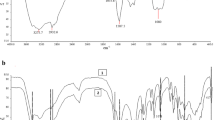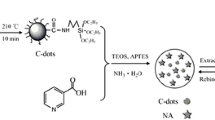Abstract
In this study, a citalopram optical nano-sensor was developed. Citalopram is a well-known antidepressant drug that reduces the reuptake of serotonin in neurons as a result, serotonin neurotransmission, the primary response to antidepressant treatments, increases in many parts of the brain. This study introduces a carbon quantum dots (CQDs)-based optical nanosensor for rapid detection of citalopram. This fluorescent nanosensor was made through the polymerization of tetraethyl orthosilicate in the presence of CQDs as the fluorescent materials and citalopram as the template molecule. Following the polymerization, the templated molecules were washed and removed from the structure, and the matrix of the polymer was left with some cavities that resembled citalopram in terms of size and shape. The final structure which is used as a chemical nanosensor, is named carbon quantum dots embedded silica molecularly imprinted polymer (CQDs-SMIP). The materials used in designing nano-sensors were characterized using FTIR, UV/Vis, and fluorescence spectroscopy, as well as high-resolution transmission electron microscopy (HR-TEM), and field emission scanning electron microscopy (FESEM). CQDs-SMIP showed a strong fluorescence emission at 420 nm in the absence of the template molecule. The fluorescence intensity of the nanosensor decreased in the presence of citalopram. The correlation between the extent of the fluorescence quenching and the concentration of citalopram provided the nano-sensor signal. The nano-sensor was used to measure citalopram in complex matrices such as human plasma and urine samples with remarkable selectivity and sensitivity. The detection limit of 10.3 µg.L-1 over a linear range of 100 to 700 µg.L-1, and RSD of 3.15% was obtained. This nano-sensor was applied to analyze of citalopram in plasma and human urine samples with remarkable results.






Similar content being viewed by others
Data availability
Not applicable.
References
Aguilar-Martinez IS et al (2020) Synergistic antidepressant-like effect of capsaicin and citalopram reduces the side effects of citalopram on anxiety and working memory in rats. Psychopharmacology 237:2173–2185. https://doi.org/10.1007/s00213-020-05528-6
Li S et al (2022) Comparative effectiveness of transcutaneous auricular vagus nerve stimulation vs citalopram for major depressive disorder: a randomized trial. Neuromodulation: Technol Neural Interface 25(3):450–460. https://doi.org/10.1016/j.neurom.2021.10.021
Anderson LL et al (2021) Citalopram and cannabidiol: in vitro and in vivo evidence of pharmacokinetic interactions relevant to the treatment of anxiety disorders in young people. J Clin Psychopharmacol 41(5):525–533. https://doi.org/10.1097/JCP.0000000000001427
Reddy AP et al (2021) Selective serotonin reuptake inhibitor citalopram ameliorates cognitive decline and protects against amyloid beta-induced mitochondrial dynamics, biogenesis, autophagy, mitophagy and synaptic toxicities in a mouse model of Alzheimer’s disease. Hum Mol Genet 30(9):789–810. https://doi.org/10.1093/hmg/ddab091/6206635
Geryk R et al (2013) HPLC method for chiral separation and quantification of antidepressant citalopram and its precursor citadiol. Chromatographia 76:483–489. https://doi.org/10.1007/s10337-013-2426-6
Klöbl M et al (2020) Predicting antidepressant citalopram treatment response via changes in brain functional connectivity after acute intravenous challenge. Front Comput Neurosci 14:554186. https://doi.org/10.3389/fncom.2020.554186
Higgins A, Nash M, Lynch AM (2010) Antidepressant-associated sexual dysfunction: impact, effects, and treatment. Drug Healthc Patient Saf 2:p141. https://doi.org/10.2147/DHPS.S7634
Nouws HP, Delerue-Matos C, and A.A (2006) Barros, Electrochemical determination of citalopram by adsorptive stripping voltammetry–determination in pharmaceutical products. Anal Lett 39(9):1907–1915. https://doi.org/10.1080/00032710600721712
Tadić S, Nikolić K, Agbaba D (2012) Development and optimization of an HPLC analysis of citalopram and its four nonchiral impurities using experimental design methodology. J AOAC Int 95(3):733–743. https://doi.org/10.5740/jaoacint.SGE_Tadic
Madej M et al (2021) A voltammetric sensor based on mixed proton-electron conducting composite including metal-organic framework JUK-2 for determination of citalopram. Microchim Acta 188(6):184. https://doi.org/10.1007/s00604-021-04835-9
Baccarin M, Cervini P, Cavalheiro ETG (2018) Comparative performances of a bare graphite-polyurethane composite electrode unmodified and modified with graphene and carbon nanotubes in the electrochemical determination of escitalopram. Talanta 178:1024–1032. https://doi.org/10.1016/j.talanta.2017.08.094
Świądro M et al (2020) Development of a new method for drug detection based on a combination of the dried blood spot method and capillary electrophoresis. J Chromatogr B 1157:122339. https://doi.org/10.1016/j.jchromb.2020.122339
Abdel-Raoof AM et al (2020) Simultaneous determination of citalopram and tadalafil by the second derivative synchronous fluorescence method in biological fluids; application of box–behnken optimization design. Luminescence 36(1):57–65. https://doi.org/10.1002/bio.3913
Das RS and Y (2012) Spectrofluorometric analysis of new-generation antidepressant drugs in pharmaceutical formulations, human urine, and plasma samples. Spectroscopy: An International Journal 27:59–71. https://doi.org/10.1155/2012/567207
Azmi SNH et al (2015) Utility of eosin Y as a complexing reagent for the determination of citalopram hydrobromide in commercial dosage forms by fluorescence spectrophotometry. Luminescence 30(8):1352–1359. https://doi.org/10.1002/bio.2905
Moffat AC et al (2004) Clarke’s analysis of drugs and poisons in pharmaceuticals, body fluids and postmortem material, 3rd edn. Pharmaceutical Press, London. Lormetazepam
Liu B et al (2019) Semiconductor quantum dots in tumor research. J Lumin 209:61–68. https://doi.org/10.1016/j.jlumin.2019.01.011
Amjadi M, Jalili R (2018) A molecularly imprinted dual-emission carbon dot-quantum dot mesoporous hybrid for ratiometric determination of anti-inflammatory drug celecoxib. Spectrochim Acta Part A Mol Biomol Spectrosc 191:345–351. https://doi.org/10.1016/j.saa.2017.10.026
Hongren L, Feng L, Aimin D (2015) A solvothermal method to synthesize fluorescent carbon nanoparticles and application to photocatalysis and electrocatalysis. Luminescence 30(6):740–744. https://doi.org/10.1002/bio.2813
Hu Q et al (2023) Silicon Doped Carbon Dots as a new ratiometric fluorescence probe for Proanthocyanidins Assay based on the Redox reaction between cr (VI) and Proanthocyanidins. J Fluoresc 33:849–858. https://doi.org/10.1007/s10895-022-03131-w
Li G-X et al (2020) Synthesis of quantum dots based on microfluidic technology. Curr Opin Chem Eng 29:34–41. https://doi.org/10.1016/j.coche.2020.02.005
Wei G et al (2012) The synthesis of highly water-dispersible and targeted CdS quantum dots and it is used for bioimaging by confocal microscopy. Spectrochim Acta Part A Mol Biomol Spectrosc 85(1):288–292. https://doi.org/10.1016/j.saa.2011.10.011
Kateshiya MR et al (2022) ) advances in ultra-small fluorescence nanoprobes for detection of metal ions, drugs, pesticides and biomarkers. J Fluoresc 33:775–798. https://doi.org/10.1007/s10895-022-03115-w. (
Li M et al (2019) Review of carbon and graphene quantum dots for sensing. ACS Sens 4(7):1732–1748. https://doi.org/10.1021/acssensors.9b00514
Wang M et al (2019) A magnetic and carbon dot based molecularly imprinted composite for fluorometric detection of 2, 4, 6-trinitrophenol. Microchim Acta 186(2):1–11. https://doi.org/10.1007/s00604-018-3200-0
Ahmadi H, Faridbod F, Mehrzad-Samarin M (2019) Entacapone detection by a GOQDs-molecularly imprinted silica fluorescent chemical nanosensor. Anal Bioanal Chem 411:1075–1084. https://doi.org/10.1007/s00216-018-1534-4
Mabrouk M et al (2020) Chitosan-based molecular imprinted polymer for extraction and spectrophotometric determination of ketorolac in human plasma. Spectrochim Acta Part A Mol Biomol Spectrosc 241:118668. https://doi.org/10.1016/j.saa.2020.118668
Takeuchi T et al (2016) Molecularly imprinted tailor-made functional polymer receptors for highly sensitive and selective separation and detection of target molecules. Chromatography 37(2):43–64. https://doi.org/10.15583/jpchrom.2016.007
Gan T et al (2018) Detection of theophylline using molecularly imprinted mesoporous silica spheres. Food Chem 268:1–8. https://doi.org/10.1016/j.foodchem.2018.06.058
Piloto AM et al (2018) Plastic antibodies tailored on quantum dots for an optical detection of myoglobin down to the femtomolar range. Sci Rep 8(1):1–11. https://doi.org/10.1038/s41598-018-23271-z
Zhou T, Halder A, Sun Y (2018) Fluorescent nanosensor based on molecularly imprinted polymers coated on graphene quantum dots for fast detection of antibiotics. Biosensors 8(3):82. https://doi.org/10.3390/bios8030082
Dong Y et al (2012) Polyamine-functionalized carbon quantum dots for chemical sensing. Carbon 50(8):2810–2815. https://doi.org/10.1016/j.carbon.2012.02.046
Wang W et al (2023) Novel green fluorescent probe stem from carbon quantum dots for specific recognition of tyrosinase in serum and living cells. J Fluoresc 33(2):739–750. https://doi.org/10.1007/s10895-022-03101-2
Amiri A, Faridbod F, Zoughi S (2021) An optical nanosensor fabricated by carbon dots embedded in silica molecularly imprinted polymer for sensitive detection of ceftazidime antibiotic. J Photochem Photobiol A 408:113111. https://doi.org/10.1016/j.jphotochem.2020.113111
Zoughi S et al (2021) Detection of tartrazine in fake saffron containing products by a sensitive optical nanosensor. Food Chem 350:129197. https://doi.org/10.1016/j.foodchem.2021.129197
Chullasat K et al (2018) A facile optosensing protocol based on molecularly imprinted polymer coated on CdTe quantum dots for highly sensitive and selective amoxicillin detection. Sens Actuators B 254:255–263. https://doi.org/10.1016/j.snb.2017.07.062
Hou J et al (2016) Rapid microwave-assisted synthesis of molecularly imprinted polymers on carbon quantum dots for fluorescent sensing of tetracycline in milk. Talanta 146:34–40. https://doi.org/10.1016/j.talanta.2015.08.024
Xu S et al (2013) Dummy molecularly imprinted polymers-capped CdTe quantum dots for the fluorescent sensing of 2, 4, 6-trinitrotoluene. ACS Appl Mater Interfaces 5(16):8146–8154. https://doi.org/10.1021/am4022076
Wang H-F et al (2009) Surface Molecular Imprinting on Mn-Doped ZnS Quantum Dots for Room-Temperature Phosphorescence Optosensing of Pentachlorophenol in Water. Anal Chem 81(4):1615–1621. https://doi.org/10.1021/ac802375a
Liu H et al (2020) Fabrication of carbon dots@restricted access molecularly imprinted polymers for selective detection of metronidazole in serum. Talanta 209:120508. https://doi.org/10.1016/j.talanta.2019.120508
Karimi-Harandi M-H et al (2022) Simultaneous determination of citalopram and selegiline using an efficient electrochemical sensor based on ZIF-8 decorated with RGO and g-C3N4 in real samples. Anal Chim Acta 1203:339662. https://doi.org/10.1016/j.aca.2022.339662
Ghaedi H et al (2016) Construction of novel sensitive electrochemical sensor for electro-oxidation and determination of citalopram based on zinc oxide nanoparticles and multi-walled carbon nanotubes. Mater Sci Engineering: C 59:847–854. https://doi.org/10.1016/j.msec.2015.10.088
Khan MN et al (2014) A validated silver-nanoparticle‐enhanced chemiluminescence method for the determination of citalopram in pharmaceutical preparations and human plasma. Luminescence 29(3):266–274. https://doi.org/10.1002/bio.2539
Khan MN et al (2013) A validated Spectrofluorimetric Method for the determination of Citalopram in Bulk and Pharmaceutical Preparations based on the measurement of the silver nanoparticles-enhanced fluorescence of Citalopram/Terbium Complexes. J Fluoresc 23(1):161–169. https://doi.org/10.1007/s10895-012-1129-y
Rebelo P et al (2022) Computational modelling and sustainable synthesis of a highly selective electrochemical MIP-based sensor for citalopram detection. Molecules 27:3315. https://doi.org/10.3390/molecules27103315
Acknowledgements
Thanks to the University of Tehran for financially supporting this work.
Funding
The Research Council of the University of Tehran supported this project.
Author information
Authors and Affiliations
Contributions
Amir Amiri and Sheida Zoughi did experimental tests. Amir Amiri and Farnoush Faridbod wrote the main manuscript text. Sheida Zoughi and Amir Amiri prepared all the figures. All authors reviewed the manuscript.
Corresponding author
Ethics declarations
Competing interests
The authors declare no competing interests.
Ethical approval
Not applicable.
Additional information
Publisher’s Note
Springer Nature remains neutral with regard to jurisdictional claims in published maps and institutional affiliations.
Electronic Supplementary Material
Below is the link to the electronic supplementary material.
Rights and permissions
Springer Nature or its licensor (e.g. a society or other partner) holds exclusive rights to this article under a publishing agreement with the author(s) or other rightsholder(s); author self-archiving of the accepted manuscript version of this article is solely governed by the terms of such publishing agreement and applicable law.
About this article
Cite this article
Amiri, A., Faridbod, F. & Zoughi, S. Selective and Rapid Optical Detection of Citalopram Using a Fluorescent Probe Based on Carbon Quantum Dots Embedded in Silica Molecularly Imprinted Polymer. J Fluoresc 34, 1171–1181 (2024). https://doi.org/10.1007/s10895-023-03323-y
Received:
Accepted:
Published:
Issue Date:
DOI: https://doi.org/10.1007/s10895-023-03323-y




